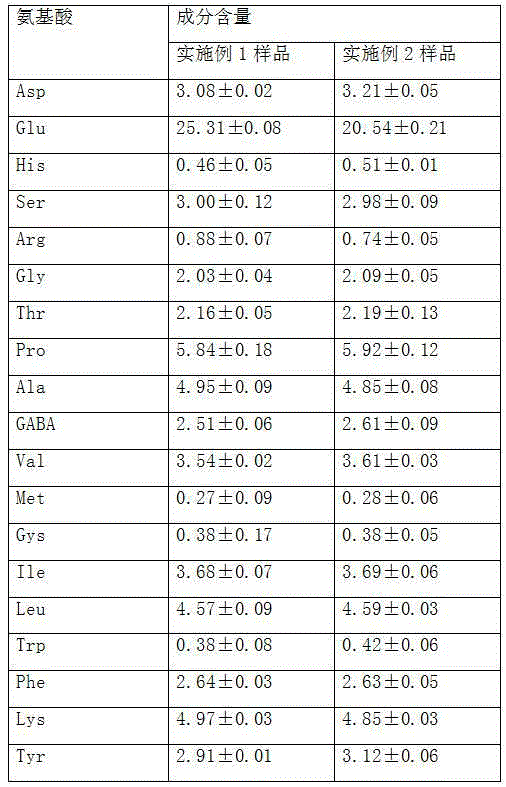Tea leaf caramel color preparation method
A tea caramel, caramel color technology, applied in the field of caramel color preparation, can solve the problems of poor hygiene index, poor quality, single salt-resistant caramel, etc.
- Summary
- Abstract
- Description
- Claims
- Application Information
AI Technical Summary
Problems solved by technology
Method used
Image
Examples
Embodiment 1
[0030] A preparation method of tea caramel color, which comprises the following steps:
[0031] 1) The caramel-colored raw materials of the tea leaves are first rinsed with green tea leaves, steamed at a high temperature of 100-105°C for 3-5 minutes, cooled to room temperature, and then put into a large ceramic vat to seal and ferment for the first time. The temperature of the fermentation environment is controlled At 30°C, 24-30 hours, stirring once every 20 hours, so that the tea leaves in the vat can be fermented more evenly for later use;
[0032] 2) Add Aspergillus sojae to the flour and stir well; take the tea leaves that have been fermented in a large tank for the first time and mix them evenly with the flour added with Aspergillus sojae. The ratio of flour to Aspergillus sojae is 5000 parts: 4 parts. The flour ratio of Aspergillus sojae is 100:8, and the temperature of the fermentation environment is controlled at 28-36°C. After 240 hours of fermentation, stir twice a ...
Embodiment 2
[0035] 1) The caramel-colored raw materials of the tea leaves are first rinsed with green tea leaves, steamed at a high temperature of 100-105°C for 3-5 minutes, cooled to room temperature, and then put into a large ceramic vat to seal and ferment for the first time. The temperature of the fermentation environment is controlled At 42°C, 30-48 hours, stirring once every 26 hours, so that the tea leaves in the vat can be fermented more evenly for later use;
[0036] 2) Add Aspergillus sojae to the flour and stir well; take the tea leaves that have been fermented in a large vat for the first time and mix them well with the flour added with Aspergillus sojae. The ratio of flour to Aspergillus sojae is 5000 parts: 6 parts. The ratio of the flour of Aspergillus sojae is 100:16, and the temperature of the fermentation environment is controlled at 28-36°C. After 360 hours of fermentation, stir twice a day, with an interval of 8-12 hours between the two times; ferment in a cool place un...
Embodiment 3
[0039] The culture process of Aspergillus sojae comprises the following steps, select the Aspergillus sojae BI spore protoplasts cultivated for 5 days, and prepare the spore suspension from fresh slant cultures where green spores begin to grow vigorously, using 25mmol / Lβ-mercaptoethanol+5mmol / LNa 2 EDTA system pretreatment for 20min, enzymolysis conditions are 1% lysozyme + 1% helicase + 1% cellulase, sorbitol osmotic pressure stabilizer (0.6mol / L, pH6.1), enzymolysis temperature 35℃, enzyme Solution 3h, medium is 0.6mol / L soybean juice medium, soybean juice medium: KH 2 PO 4 1g, MgSO 4 015g (NH 4 ) 2 SO 4 0.15g, soluble starch 20g, agar powder 20g, soybean juice 1000mL, regenerated by coating method, cultivated for 18 hours, 1000r / min, and centrifuged for 8 minutes to obtain Aspergillus sojae.
PUM
 Login to View More
Login to View More Abstract
Description
Claims
Application Information
 Login to View More
Login to View More - R&D
- Intellectual Property
- Life Sciences
- Materials
- Tech Scout
- Unparalleled Data Quality
- Higher Quality Content
- 60% Fewer Hallucinations
Browse by: Latest US Patents, China's latest patents, Technical Efficacy Thesaurus, Application Domain, Technology Topic, Popular Technical Reports.
© 2025 PatSnap. All rights reserved.Legal|Privacy policy|Modern Slavery Act Transparency Statement|Sitemap|About US| Contact US: help@patsnap.com

